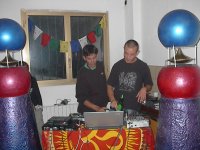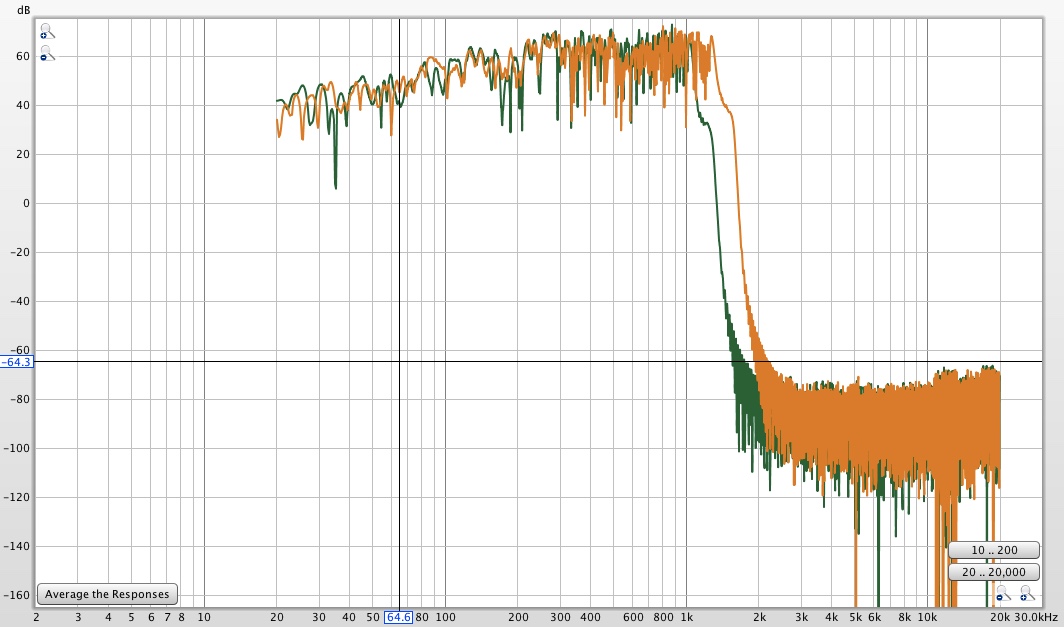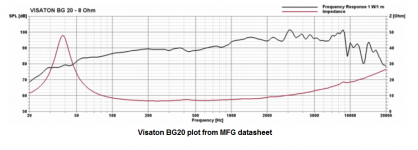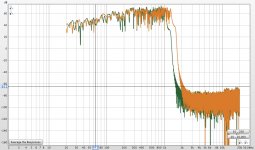What are the cones made of? They should be hard, smooth, and reflective.
The BG20 is an inexpensive 8” whizzer cone with a paper cone.

dave
Yes, exactly. This may helpWouldn't a parabolic shaped cone basically create a circular exponential horn?
Like this:
venus high end loudspeaker
http://www.audioheritage.org/vbulle...Horn-speaker-2426H&highlight=omni+directional
Have you tried listening to them with the reflectors off? Just curious if their "toy" sound goes away with that factor.
I'm using 1m, 4" tubes to break in a set of MA Pluvia HDs. They want to be at least 1M out into the room, and there they make a really neat spatial effect - no reflector, just the driver pointing straight up. I cant even imagine how they work like that and it is somewhat intriguing, even if it's an "effect" that I assume one could get tired of.
Makes me wonder what they'd sound like hanging from the ceiling...
On the other hand, I can see how this effect could remain enjoyable for an ambient or background listening application, where you're not looking for a what musician is in what seat levels of soundstage precision.
The up-firing speaker is something I'm going to continue to play with in my remaining years as an audiophile!
I'm using 1m, 4" tubes to break in a set of MA Pluvia HDs. They want to be at least 1M out into the room, and there they make a really neat spatial effect - no reflector, just the driver pointing straight up. I cant even imagine how they work like that and it is somewhat intriguing, even if it's an "effect" that I assume one could get tired of.
Makes me wonder what they'd sound like hanging from the ceiling...
On the other hand, I can see how this effect could remain enjoyable for an ambient or background listening application, where you're not looking for a what musician is in what seat levels of soundstage precision.
The up-firing speaker is something I'm going to continue to play with in my remaining years as an audiophile!
Last edited:
So if you are an audiophile music lover, I'd ensure I'd have one good seat (maybe two, depending) for attending to music (OK, maybe reading a book too). If you want to sit anywhere and have just some background "elevator" music, that ain't an audiophile design problem although perhaps worthy of serious design effort such as you are trying so nicely to achieve.
These days for good low bass, seems pretty necessary to sneak a few extra subs around the room and plain silly not to have a Behringer DCX2496 DSP to tailor the XO and a bit of EQ.
If that is feasible or if that isn't, can you explain what you are trying to achieve beyond that. Don't forget, the audiophile system and the background system can mix-and-match shared components.
I sure wish people would stop posting what they think are clever solutions to a problem that hasn't been explained.
B.
These days for good low bass, seems pretty necessary to sneak a few extra subs around the room and plain silly not to have a Behringer DCX2496 DSP to tailor the XO and a bit of EQ.
If that is feasible or if that isn't, can you explain what you are trying to achieve beyond that. Don't forget, the audiophile system and the background system can mix-and-match shared components.
I sure wish people would stop posting what they think are clever solutions to a problem that hasn't been explained.
B.
Last edited:
The biggest advantage of omnidirectional speakers is that the reflections from back or sidewalls contain the proper amount of treble frequencies not muffled like conventional ones.
This is more natural and our brain can handle and integrate them easily into a 3-dimensional picture.
When you walk around in the room, the character of the sound doesn't change, only near walls and corners, but that is another lunch.
Anyway fantastic for DJ-ing.

This is more natural and our brain can handle and integrate them easily into a 3-dimensional picture.
When you walk around in the room, the character of the sound doesn't change, only near walls and corners, but that is another lunch.
Anyway fantastic for DJ-ing.

...and there they make a really neat spatial effect - no reflector, just the driver pointing straight up. I cant even imagine how they work like that and it is somewhat intriguing, even if it's an "effect" that I assume one could get tired of.
Now imagine a castle configuration :^)
dave
Ok, I'm imagining!
I have a Alpair 5(A) set as well as the Pluvia 7 HDs. Would it be possible to do a microtower with the Pluvia firing up, the Alpair firing front, perhaps now with a little asymmetrical baffle offset?
Or would that upset the balance of the cabinet and require a new design for the spec differences between needing a 4" and getting a waaay different 3" driver in the front position?
Of course, imagining is one thing, taking that into a working design is another!
I have a Alpair 5(A) set as well as the Pluvia 7 HDs. Would it be possible to do a microtower with the Pluvia firing up, the Alpair firing front, perhaps now with a little asymmetrical baffle offset?
Or would that upset the balance of the cabinet and require a new design for the spec differences between needing a 4" and getting a waaay different 3" driver in the front position?
Of course, imagining is one thing, taking that into a working design is another!

Have you tried listening to them with the reflectors off? Just curious if their "toy" sound goes away with that factor.
It actually doesn't make much of a difference.
The first questions I would ask are:
What is the crossover or EQ/shaping circuit used? If the answer is "none" I believe we have found the culprit right away.
Assuming you are using some kind of filter/shaping circuit, how did you design it? Did you take measurements on the driver and use those to design the circuit? Did you estimate/guesstimate how to EQ the speaker? Etc.
Please answer those questions.
Next up would be the "diffuser/reflector" thingy. What is that made of? I think I saw a mention of "foam". It looks like a buoy or something, e.g. a soft material. You need a very hard surface to reflect the sound outwards. Foam would be a bad choice. You could replace it with a large funnel - plastic is easy to cut. Get a cheap kitchen funnel at least 6" in diameter (based on your 8" driver) and try that. A material like aluminum or other metal would be even better, with a very smooth surface.
If you want an example of a very good sounding omni system, check out Linkwitz's Pluto speaker. The main differences from what you are doing are: its a 2-way. A 1" fullrange speaker handles the high frequencies - it is omni up to several kHz. A 5.25" midwoofer fires upwards, and because of the small diameter of the driver it is omni to almost 1kHz. The crossover occurs somewhere between 500Hz and 1kHz. Sounds awesome. Your larger driver departs from omni behavior at a lower frequency, so keep this in mind if you want to try an do a 2-way omni. Probably need to cross over no higher than 500Hz. You might use a 3" fullranger in the smallest enclosure you can manage as the "tweeter". For example the Peerless TG9 is on sale at Parts Express today.
What is the crossover or EQ/shaping circuit used? If the answer is "none" I believe we have found the culprit right away.
Assuming you are using some kind of filter/shaping circuit, how did you design it? Did you take measurements on the driver and use those to design the circuit? Did you estimate/guesstimate how to EQ the speaker? Etc.
Please answer those questions.
Next up would be the "diffuser/reflector" thingy. What is that made of? I think I saw a mention of "foam". It looks like a buoy or something, e.g. a soft material. You need a very hard surface to reflect the sound outwards. Foam would be a bad choice. You could replace it with a large funnel - plastic is easy to cut. Get a cheap kitchen funnel at least 6" in diameter (based on your 8" driver) and try that. A material like aluminum or other metal would be even better, with a very smooth surface.
If you want an example of a very good sounding omni system, check out Linkwitz's Pluto speaker. The main differences from what you are doing are: its a 2-way. A 1" fullrange speaker handles the high frequencies - it is omni up to several kHz. A 5.25" midwoofer fires upwards, and because of the small diameter of the driver it is omni to almost 1kHz. The crossover occurs somewhere between 500Hz and 1kHz. Sounds awesome. Your larger driver departs from omni behavior at a lower frequency, so keep this in mind if you want to try an do a 2-way omni. Probably need to cross over no higher than 500Hz. You might use a 3" fullranger in the smallest enclosure you can manage as the "tweeter". For example the Peerless TG9 is on sale at Parts Express today.
Last edited:
The first questions I would ask are:
What is the crossover or EQ/shaping circuit used? If the answer is "none" I believe we have found the culprit right away.
None. I have miniDSP. If I could figure out, I could EQ it.
Next up would be the "diffuser/reflector" thingy. What is that made of? I think I saw a mention of "foam". It looks like a buoy or something, e.g. a soft material. You need a very hard surface to reflect the sound outwards. Foam would be a bad choice. You could replace it with a large funnel - plastic is easy to cut. Get a cheap kitchen funnel at least 6" in diameter (based on your 8" driver) and try that. A material like aluminum or other metal would be even better, with a very smooth surface.
It's made of wood discs covered in Bondo. Bondo is like epoxy it is very hard, solid and heavy.
OK, thanks for the info.
So, one thing you can try with the MiniDSP is to use a shelving filter (I think the GUI provides an option for that) to shelve down the treble between 500Hz (0dB) and 1kHz (-6dB). Its a first order (-6dB/octave) shelving filter. Try that. It will change the tonal balance to be less "bright" and "toy like".
Are you familiar with how to configure and use the MiniDSP?
So, one thing you can try with the MiniDSP is to use a shelving filter (I think the GUI provides an option for that) to shelve down the treble between 500Hz (0dB) and 1kHz (-6dB). Its a first order (-6dB/octave) shelving filter. Try that. It will change the tonal balance to be less "bright" and "toy like".
Are you familiar with how to configure and use the MiniDSP?
Attached is the response plot that the manufacturer of your driver (Visaton, model BG20) provides in the datasheet. Between 700Hz and 1500Hz the level rises by about 6-7dB. This is the area you should target (as a first attempt) to EQ using the miniDSP. You COULD do this with a passive network, but since you have the MiniDSP it will be much simpler to just use that (at least at first) because you can change the extent and frequency of the shelf EQ until you arrive at something that sounds good.
Do you think you can try that?
Do you think you can try that?
Attachments
OK, thanks for the info.
So, one thing you can try with the MiniDSP is to use a shelving filter (I think the GUI provides an option for that) to shelve down the treble between 500Hz (0dB) and 1kHz (-6dB). Its a first order (-6dB/octave) shelving filter. Try that. It will change the tonal balance to be less "bright" and "toy like".
Are you familiar with how to configure and use the MiniDSP?
Not very well. I can take measurements with the UMIK, and I can upload profiles into the miniDSP, but my first measurements of the omnis were downright weird looking. See attached. It left me wondering if I made a mistake. If I didn't make a mistake, I need to take the file and EQ it, but there are a dizzying array of options and I got a little lost.
Attachments
Are you measuring just one speaker with a gating of 3-5ms at 1 meter? Getting reliable nearfield speaker measurements can be a bit of a learning curve. I've been playing with REW and Umik-1 the last months myself..
Are you measuring just one speaker with a gating of 3-5ms at 1 meter? Getting reliable nearfield speaker measurements can be a bit of a learning curve. I've been playing with REW and Umik-1 the last months myself..
No. These are an in room measurements taken from each speaker from a seated position about 2 meters away. I don't know what gating is, but I can look it up. I can also take them outside or something if that's a better idea.
Your measurements look like there is a very high order lowpass filter being used at 1.4kHz (green) and 1.8kHz (red):

Did you take these measurements while using the MiniDSP or are they just of the speaker without any filters?
This steep of a filter looks like it might be an FIR filter of some kind. Perhaps your miniDSP has one enabled? Did you get it second hand? If so did you clear it or restore factory default setttings or something like that?
Did you take these measurements while using the MiniDSP or are they just of the speaker without any filters?
This steep of a filter looks like it might be an FIR filter of some kind. Perhaps your miniDSP has one enabled? Did you get it second hand? If so did you clear it or restore factory default setttings or something like that?
Last edited:
Did you take these measurements while using the MiniDSP or are they just of the speaker without any filters?
This steep of a filter looks like it might be an FIR filter of some kind. Perhaps your miniDSP has one enabled? Did you get it second hand? If so did you clear it or restore factory default setttings or something like that?
The MiniDSP was connected when I took the measurement, but I don't think there were any filters applied. It's a new unit and I also did a default reset at one point while reading about it. I could try again and make sure I do a reset.
You can try removing the MiniDSP from the playback chain entirely and then taking another measurement. That would rule it in or out as the source of the problem.
I use ARTA for making measurements. It's free software. I wrote a tutorial on making gated measurements that you can find here:
http://audio.claub.net/tutorials/FR measurement using ARTA.pdf
I use ARTA for making measurements. It's free software. I wrote a tutorial on making gated measurements that you can find here:
http://audio.claub.net/tutorials/FR measurement using ARTA.pdf
So at this point, we have a weird FR (which could be instantly verified by playing a trumpet recording) and "There seems to be a distinct lack of low-mid frequencies before the sub fills in. At the same time, I can tell that they have promise".
Why do we waste time on such threads where the OP might as well be just kidding? Covid-19 boredom?
If OP wants some help, time for him to supply coherent information.
B.
Why do we waste time on such threads where the OP might as well be just kidding? Covid-19 boredom?
If OP wants some help, time for him to supply coherent information.
B.
- Home
- Loudspeakers
- Planars & Exotics
- Please Critique My DIY Omnis!

